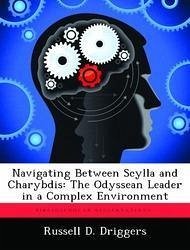The tale of Odysseus and his encounter with Scylla and Charybdis is an instructive metaphor for considering theories of organizational design and leadership. The tale speaks of navigating between two extremes where dodging one increases the risk from the other. On the one side of the strait sits Charybdis, the "old way of doing things." On the other lies a radical new approach to our understanding of leadership and organizational structure. Not as well known, it can be likened to the Scylla. Instead, perhaps it would be wise to take a cue from Odysseus and navigate between the two views in a balanced approach to organizational structure and leadership. Some leadership and organizational theorists do not agree. They argue that the Industrial-Age approach to organizations generates stodgy, vertical hierarchies incapable of relevant response when faced with an adaptive environment of increasing complexity, volatility, and ambiguity. They point to business failures as well as Operation IRAQI FREEDOM as examples of organizational failures to adapt. Instead, they argue it is time to radically alter our concept of leadership and organizational structure. They advocate flattening organizations to improve knowledge flows and foster innovative thinking. These organizations, they argue promise to explore the potential of human cooperation and create genuine creative organizational adaptation to a complex environment. In attempting to sweep away the old order, however, key merits of the Industrial-Age approach are lost. Likewise, the uncritical adoption of these new radical ideas may pose dangerous risks. What is needed, then, is a different approach to leadership and organizations--one that recognizes the strengths and weaknesses of both views and posits a role of leadership that, like Odysseus, effectively navigates between the two. In this approach--the Odyssean leadership approach--an organizational leader navigates a course between seeming contradictions and paradoxes. Th








